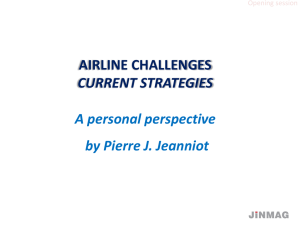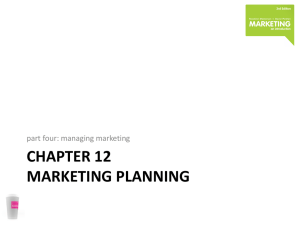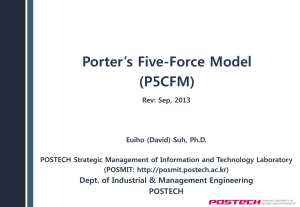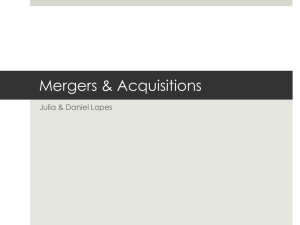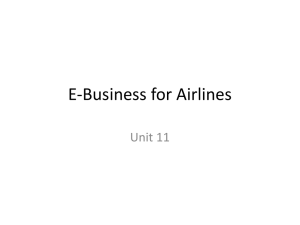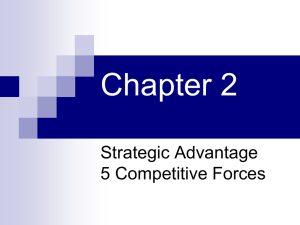File
advertisement
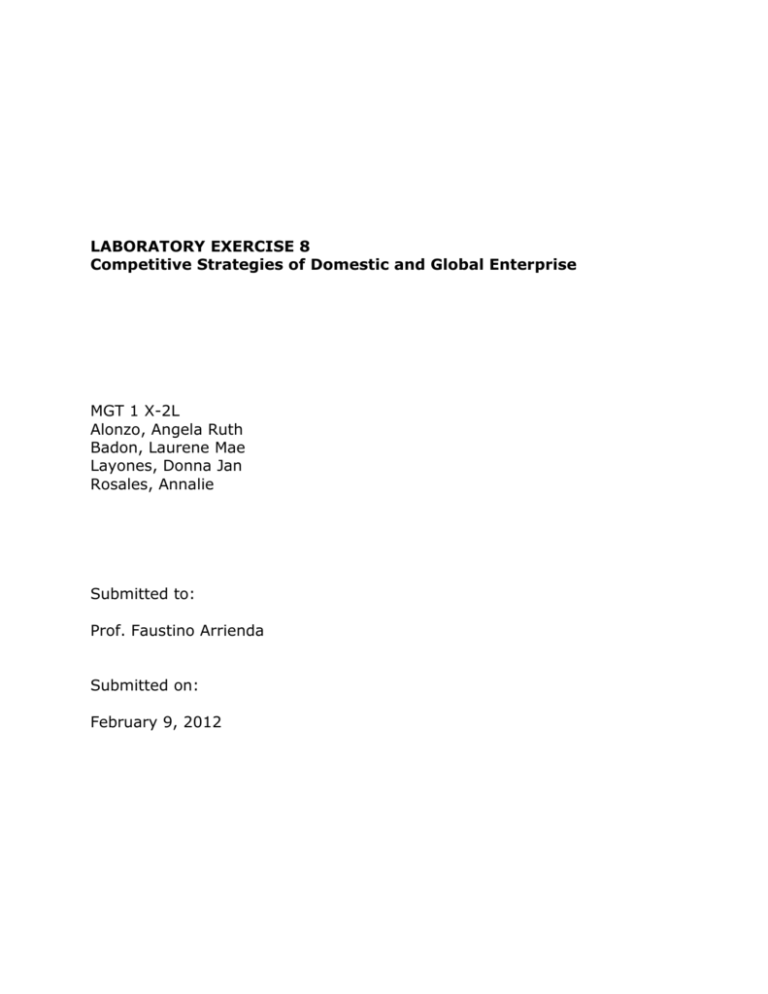
LABORATORY EXERCISE 8 Competitive Strategies of Domestic and Global Enterprise MGT 1 X-2L Alonzo, Angela Ruth Badon, Laurene Mae Layones, Donna Jan Rosales, Annalie Submitted to: Prof. Faustino Arrienda Submitted on: February 9, 2012 Airline Airline industry Porter’s 5 forces -factors affecting the 5 forces (commonly) -relate to airline industry Effect of globalization on airline industry >what is globalization In the Philippines, there are approximately 30 airlines which can be classified into three main categories: scheduled commercial, charter, and cargo airlines. There are five competing commercial airlines that have domestic and international routes. These are the airlines which are ranked according to their market share: (1) Cebu Pacific, (2) Philippine Airlines / AirPhil Express, (3) Zest Airways, (4) SEAir,and (5) Spirit of Manila Airlines. The most influential analytical model for assessing the nature of competition in an industry is Michael Porter’s Five Forces Model. Porter, a Professor from Harvard University, explains that there are five forces that determine industry attractiveness and long-run industry profitability. These five “competitive forces” are: (1) threat of entry of new competitors (or new entrants); (2) threat of substitutes; (3) bargaining power of buyers; (4) bargaining power of suppliers; and (5) degree of rivalry between existing competitors. Figure 8.1. Diagram of Porter’s Five Forces. THREAT OF NEW ENTRANTS The threat of new entrants to an industry can raise the level of competition, thereby reducing its attractiveness. The threat of new entrants largely depends on the barriers to entry. High entry barriers exist in some industries whereas other industries are very easy to enter. The key barriers to entry include: economies of scale, capital or investment requirements, customer switching costs, access to industry distribution channels, and the likelihood of retaliation from industry of existing players. Airline Industry is a business which requires huge setup thus large investment, in old times this industry might have a very less threat but today banks has increased possibilities of new entrants through offering long term loans on less interest to business sectors which obviously increased the threat of new entrants for the existing airlines. There is always possibility that another airline will be formed to service the existing market. The likeliness of another airlines being formed, will depend so much on the barrier to entry and the lucrativeness of the business In relation to Philippines’ airline industry, Zest Airways is the newcomer that is currently competing with the two airline giants – Cebu Pacific and Philippine Airlines (PAL). As a starting company in this business, they offer low rates to the passengers. more clients. The unique strategy of Zest offers tour packages wherein tourists affordable and very convenient because agencies. They also have promos to attract Air from the other airlines is that it can set their travel plans-more they do not have to go to travel BARGAINING POWER OF SUPPLIERS Suppliers are the businesses that supply materials and other products into the industry. The cost of items bought from suppliers (e.g. raw materials, components) can have a significant impact on a company’s profitability. If suppliers have high bargaining power over a company, then the company’s industry is less attractive. The bargaining power of suppliers will be high when: there are many buyers and few dominant suppliers, there are undifferentiated and highly valued products, suppliers threaten to integrate forward into the industry, buyers do not threaten to integrate backwards into supply, and the industry is not a key customer group to the suppliers. In short, suppliers, if powerful, can exert an influence on the producing industry, such as selling raw materials at a high price to capture some of the industry's profits. Thus, lowers the profit of an industry. In relation to airline industry, there are only two competing airline manufacturing companies which supply airplanes to different countries. These are Boeing and Airbus. Some airlines operate using a single type of aircraft, for example Boeing only or Airbus only. The seller will have a greater power over the airline. For that reasons, most airlines will opt for multiple suppliers. It will also have the added advantage of getting a better deal, because if Boeing has an unattractive deal, the airline will shift to Airbus. Having more suppliers will decrease the price of the airplanes considering that there are also various airlines. By 2020, China envisioned to manufacture airplanes, making it a possible competitor to Boeing and Airbus. http://www.slideshare.net/joharahman/five-forces-in-airline-industry http://tutor2u.net/business/strategy/porter_five_forces.htm http://www.docstoc.com/docs/29471588/Competitive-Analysis-of-AirlineIndustry-using-porter-five-forces-model http://www.quickmba.com/strategy/porter.shtml BARGAINING POWER OF BUYERS The power of buyers increase when there are few dominant buyers and many sellers in the industry. Some companies have small number of customers which purchase a high volume of the products. Taking the example of Malaysian Helicopter Services (MHS) who has customer like SHELL and PETRONAS, will acknowledge the power these two buyers have. They can dictate what type of helicopter to operate and the price of the tickets. For airline such as MAS, with multiple segments and without single large customer, the power of the buyer is not too obvious. Buyers dictate the demand in the industry. Like in airline industry, the sales of the airline depend on the number of passengers who have reserved tickets for a particular flight. DEGREE OF RIVALRY The intensity of rivalry between competitors in an industry depends on six factors: (1) The structure of competition, rivalry is more intense where there are many small or equally sized competitors; (2) - The structure of industry costs, industries with high fixed costs encourage competitors to fill unused capacity by price cutting; (3) Degree of differentiation, industries where products are commodities (e.g. steel, coal) have greater rivalry; (4) Switching costs, rivalry is reduced where buyers have high switching costs; (5) Strategic objectives, when competitors are pursuing aggressive growth strategies, rivalry is more intense; and (6) Exit barriers, when barriers to leaving an industry are high then competitors tend to exhibit greater rivalry. In the airline industry, the competition among the airlines is quite high especially between Cebu Pacific and Philippine Airlines. Both companies go to the same destination for domestic flights. Cebu Pacific has promos that cut the costs of the airline ticket. This promo encourages more passengers/buyers to ride with them. One difference between PAL and Cebu Pacific is that airfare for the domestic flights of PAL are inclusive of a snack unlike in the flights of Cebu Pacific. http://tutor2u.net/business/strategy/porter_five_forces.htm http://www.slideshare.net/joharahman/five-forces-in-airline-industry

